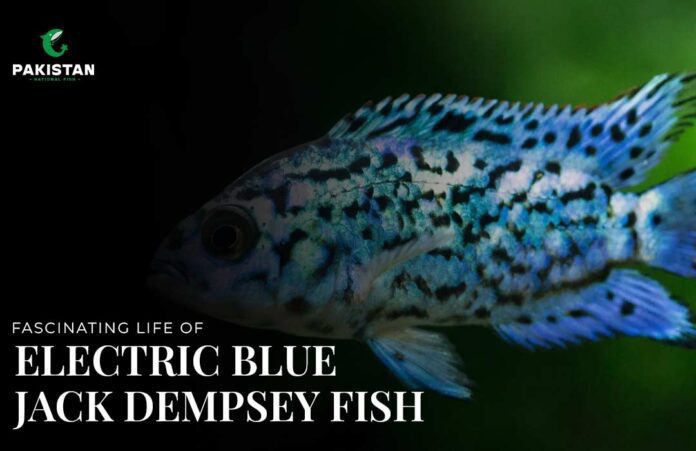Electric Blue Jack Dempseys are among the brightest freshwater aquarium species available to hobbyists surely won’t come as a surprise to you if you’ve ever seen one in person. Consider avoiding the Electric Blue Jack Dempsey if you’re searching for a little, calm fish. However, if you’re okay with a species that is a little aggressive, the Electric Blue Jack Dempsey could become your new favourite fish.
This article will cover maintenance, common illnesses, tank mates, and even the background to this fish’s name. You’ll have all the knowledge you need to determine whether or not this unusual fish is the right addition to your freshwater fish tank after reading this article.
Habitat and Origin
Compared to the typical Jack Dempsey fish, this variety is far rarer, and its origin is highly debatable. Many maintain that this species is native to Central America and the Mexican Atlantic coast. Some, however, assert that Hector Luzardo, an Argentine breeder, was responsible for creating the fish.
To this day, more DNA research is needed to ascertain if the Electric Blue Jack Dempsey’s distinct colouration results from hybridization—the mating of two different species—or morphing, or genetic mutation.
Physical Characteristics of Jack Dempsey Fish

The flat, oval body of the Jack Dempsey fish is adorned with a rounded tail fin, eight to ten spines on the bottom fin, and 17 to 19 spines on the top fin. Although it can reach a maximum length of 25 centimetres, it typically grows to be between 7 and 20 centimetres long.
Colours are one of the most recognized and valued aspects of Jack Dempsey fish. From the tops of their heads all the way forward to in between their eyes, two grey-black bars run. Adult Jack Dempsey fish have multiple rows of vivid green, blue, and white shimmery spots on their head, body, and fins, giving them an extremely appealing appearance.
Some mature Jack Dempsey fish have a bright blue hue all over their body; these fish are known as electric blue Jack Dempsey. Their genes naturally experienced a mutation that caused this.
Fry are young hatchlings that have turquoise spots on a pale grey background that act as a natural defence against predators.
Lifespan
The lifespan of aquarium fish is generally related to stress, water quality, and diet, just like it is for almost all fish. The Electric Blue Jack Dempsey will be able to live a healthy life if you provide it with a large tank.
A healthy Electric Blue Jack Dempsey fish kept in captivity should last hobbyists 10 to 15 years. Electric Blue Jack Dempsey fish that are bought are typically adults, 1 to 2 years of age. When buying, you might want to think about asking how old the fish is so you know roughly how long it will last.
Breeding
Breeding Jack Dempsey fish is not that difficult. Breeding this fish can be highly satisfying if you are lucky enough to discover a male/female pair that hails from two different family lines.
When these fish are ready to spawn, you can tell because their electric blue hue will turn black. This coat, often known as “the black breeding coat,” is a reliable sign that it’s time to move a male and female pair into a breeding tank.
Decorations for your breeding tank should include plants or stones that the female will use to lay her eggs. This tank should have somewhat warmer temperatures than your primary aquarium, and more frequent water changes should be made.
Common Illness in Electric Blue Jack Dempsey Fish
Dropsy and White Spot Disease are common illnesses in fish.
1. Dropsy
Frequently observed in stressed fish as a result of low water quality. Fish immune systems deteriorate, which lets germs grow. Fish lose their appetite, become motionless, or become lethargic. The fish’s enlargement, which resembles a balloon bursting, is the most obvious symptom.
Cure For Dropsy: Move the fish to an adult hospital tank with perfect water conditions. Gradually add Epsom salt to the tank. Monitor water quality in the hospital tank for a week. If the fish seems better, return to the main tank.
2. White Spot Disease
Fish with this disease develop white patches.
Cure For White Spot Disease:Water changes and temporary aquarium temperature increases are required. Raising the temperature to 85°F aids in eradicating the parasite.
Tank maintenance for Electric Blue Jack Dempsey
Use a heat pump and a quality filtration system to keep the water in your fish tank between 22 and 30 degrees Celsius to keep it healthy. Before introducing the fish, give the filter a 24-hour rest and clean it using fresh water instead of tap water.
Maintain a pH and hardness range of 6.5 to 8.0 for your water, and plan an eight to ten-hour light cycle each day. Keep the tank away from windows to prevent hazardous cycles of light and water temperature.
Tank Mates
As the Electric Blue Jack Dempsey fish exhibits semi-aggression, caution must be exercised while introducing new tankmates.
It is advisable to include huge, semi-aggressive tank mates. The Electric Blue Jack Dempsey will harass fish with a calm disposition, while larger fish, such as Firemouth Cichlids, will defend themselves and get along well with an Electric Blue. Here are a few possible tankmates we suggest:
- Convict Cichlids
- Blue Acara
- Clown Loaches
- Rainbow Fish
- Severum Cichlids
- Green Terrors
- Jaguar Cichlids
Don’t introduce tiny fish like Danios, endlers, or tetras. These gentle little fish are just too little to coexist with an electric blue.
Conclusion
Having an electric blue jack Dempsey fish is worthwhile if you wish to be fascinated with the unique colours and unusual habits of fish. They are a lot of fun wherever they are in an aquatic environment as long as their native habitat is respected.


